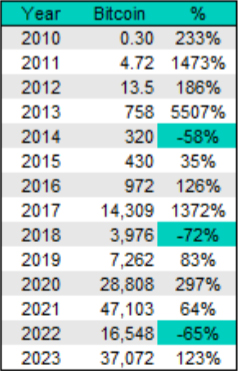
Summary: During Bitcoin halving years, we have seen rallies of +186% (2012), +126% (2016) and +297% (2020). At a Bitcoin price of 40,000 per coin, twenty-five thousand coins equate to $1 billion – or 250,000 Bitcoins equate to $10 billion. Compare this to the approximately 328,125 Bitcoins that were (will be) mined in 2023. A BlackRock Bitcoin ETF could scoop up 76% of all the supply from the mining community – not even considering that rewards will be cut in half from April 2024 onwards. Only 5.8 million of the 19.4 million mined Bitcoins have been moved during the last year, signaling that 70% of coins are just held for longer. 2.4 million Bitcoins appear to have been moved during the last six months, and this short-term holder supply could indeed be seen as the true free-float of the Bitcoin market.
Analysis
While everybody is aware that Bitcoin prices tend to go up during years when Bitcoin mining rewards are slashed in half (2012, 2016, and 2020), hardly anybody knows why this is happening. Based on our analysis, it is because the Bitcoin miners are restricting the flow onto exchanges and therefore suffocating supply – what’s left is a one-way demand from fiat investors – hence, we have seen rallies of +186% (2012), +126% (2016) and +297% (2020) during those years. Roughly, +196%, on average, when the four-year halving cycle occurred.
Based on this metric, the Bitcoin price will triple in 2024.
Exhibit 1: 2014 down, followed by three up, 2018 down, followed by three up, 2022 down…

BlackRock manages $10 trillion of client money, and since the company announced its Bitcoin Spot ETF application in June this year, we have been analyzing the potential inflows into Bitcoin. The most important consideration is that any bank linked to a U.S. brokerage account could suddenly be used to on- ramp into crypto – indirectly through an ETF, but nevertheless. This fiat-to-crypto onramp was severely impaired after the FTX implosion in November 2022 and the subsequent dismantling of three U.S. banks in March 2023. Hence, a Bitcoin Spot ETF is a significant development.
Our assumptions and estimates focused on a 20% reallocation from gold and silver ETFs, which have a market capitalization of $120 billion – therefore $24 billion of inflows – towards the higher end of $50 billion, which is derived from 1% of the assets some Registered Investment Advisors (RIA) manage as those investors predominantly use ETF for asset allocation decisions.
With an $800 billion market cap and $25 to $50 billion of new inflows appear doable, but on second thought, it seems rather challenging and could exaggerate the ‘short-squeeze’ we have been projecting during the last couple of months. First, we compared the time between the 2017 CME Bitcoin futures announcement and the actual listing of the futures, which resulted in a rally of +180% – everybody knew there was strong demand; the higher the prices, the more demand – FOMO.
At a Bitcoin price of 40,000 per coin, twenty-five thousand coins equate to $1 billion – or 250,000 Bitcoins equate to $10 billion. Compare this to the approximately 328,125 Bitcoins that were (will be) mined in 2023. As the miners are the most reliable group that would eventually have to sell due to corporate and shareholder responsibilities, a BlackRock Bitcoin ETF could scoop up 76% of all the supply from the mining community – not even considering that rewards will be cut in half from April 2024 onwards. This is based on an extremely conservative estimate of only $10 billion flowing into the Bitcoin Spot ETFs. Imagine $20 billion or $30 billion – there will be a massive squeeze.
Luckily, as a regulated entity, BlackRock (and other ETF providers) will be forced to deal with regulated entities. While 1.8 million Bitcoins ($72 billion) are on exchanges, most are held on unregulated exchanges. Of course, a massive transfer from unregulated to regulated exchanges will occur. Still, as the balance on exchanges has declined by -10% during the last year, many excess coins might not be available for ETF issuers – unless prices might materially move higher.
Only 5.8 million of the 19.4 million mined Bitcoins have been moved during the last year, signaling that 70% of coins are just held for longer. 2.4 million Bitcoins appear to have been moved during the last six months, and this short-term holder supply could indeed be seen as the true free-float of the Bitcoin market. There is no doubt that with the entrance of another massive accumulator of Bitcoins, prices will continue to rise. Other market participants are waking up to this fact, and that’s why we are seeing this squeeze.
Exhibit 2: Only 328,125 will be added in 2023, $10 billion ETF inflow equates to 250,000 coins

Disclaimer
This article reflects the personal views of its author, not Deribit or its affiliates. Deribit has neither reviewed nor endorsed its content.
Deribit does not offer investment advice or endorsements. The information herein is informational and shouldn’t be seen as financial advice. Always do your own research and consult professionals before investing.
Financial investments carry risks, including capital loss. Neither Deribit nor the article’s author assumes liability for decisions based on this content.
AUTHOR(S)
